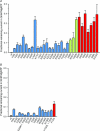The role of the KATP channel in glucose homeostasis in health and disease: more than meets the islet
- PMID: 20519313
- PMCID: PMC2976015
- DOI: 10.1113/jphysiol.2010.191767
The role of the KATP channel in glucose homeostasis in health and disease: more than meets the islet
Abstract
ATP-sensitive potassium (K(ATP)) channels are critical for the maintenance of glucose homeostasis. They are essential for glucose-stimulated insulin secretion from pancreatic beta-cells, contribute to the mechanisms by which hypoglycaemia stimulates glucagon release from pancreatic alpha-cells, and are involved in glucose uptake into skeletal muscle, glucose production and release from the liver, and feeding behaviour. Not surprisingly, loss- or gain-of-function mutations in K(ATP) channel genes have profound effects, giving rise to congenital hyperinsulinaemia and neonatal diabetes respectively. This symposium review focuses on our current understanding of the role of the K(ATP) channel in glucose homeostasis in health and disease.
Figures





References
-
- Ashcroft FM. The Walter B. Cannon Physiology in Perspective Lecture, 2007. ATP-sensitive K+ channels and disease: from molecule to malady. Am J Physiol Endocrinol Metab. 2007;293:E880–889. - PubMed
-
- Ashcroft FM. New uses for olddrugs: neonatal diabetes and sulphonylureas. Cell Metab. 2010;11:179–181. - PubMed
-
- Ashcroft FM, Harrison DE, Ashcroft SJ. Glucose induces closure of single potassium channels in isolated rat pancreatic β-cells. Nature. 1984;312:446–448. - PubMed
-
- Baukrowitz T, Fakler B. KATP channels: linker between phospholipid metabolism and excitability. Biochem Pharmacol. 2000;60:735–740. - PubMed
-
- Bernard C. Lecons de Physiologie Experimentale Appliquee a la Medecine. Paris: Baillere et Fils; 1855. pp. 296–313.
Publication types
MeSH terms
Substances
Grants and funding
LinkOut - more resources
Full Text Sources
Other Literature Sources
Medical

